publications
publications by categories in reversed chronological order. generated by jekyll-scholar.
2023
-
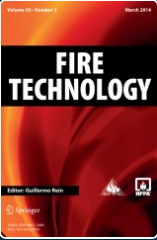 Numerical Simulations of Gas Burner Experiments in a Residential Structure with HVAC SystemDushyant M. Chaudhari, Craig Weinschenk, and Jason E. FloydFire Technology, Mar 2023
Numerical Simulations of Gas Burner Experiments in a Residential Structure with HVAC SystemDushyant M. Chaudhari, Craig Weinschenk, and Jason E. FloydFire Technology, Mar 2023Controlled fire experiments using a gas burner were previously conducted in a purpose-built, two-story, moderately air-tight residential structure to understand the effect of a heating, ventilating, and air conditioning (HVAC) system and door positions on the fire-induced environment. Temperatures, gas concentrations (oxygen, water vapor, carbon dioxide), and differential pressures were monitored throughout the structure. HVAC status (off vs. on) and stairwell door position of the fire room (open vs. closed) were varied for the experiments analyzed in this paper. In this study, Fire Dynamics Simulator (FDS) v. 6.7.9 was used to simulate these experiments. Experimental data quantifying the air tightness of the building and cold flowrates through HVAC vents were determined to be important to optimize leakages and HVAC loss coefficients for the simulation setup. Pressure development in the structure was predicted correctly to be higher on the first floor and lower in the basement, but the magnitude of steady-state pressure was underpredicted. The measured and predicted steady-state temperature distributions were statistically different for the cases with and without the HVAC on, regardless of the door position. FDS predicted gas transport through the HVAC duct network, and under-predicted temperature rise and water vapor content by about 9% and 10%, respectively, and over-predicted volumetric oxygen and carbon dioxide content by about 21% and 6%, respectively. Temperature rise prediction in the closed room, where the gas transport primarily occurred via the HVAC duct network, improved after including heat loss from the HVAC duct to the ambient.
2021
-
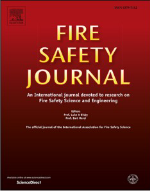 Comparison of Pyrolysis Properties of Extruded and Cast Poly(Methyl Methacrylate)Gregory J. Fiola, Dushyant M. Chaudhari, and Stanislav I. StoliarovFire Safety Journal, Mar 2021
Comparison of Pyrolysis Properties of Extruded and Cast Poly(Methyl Methacrylate)Gregory J. Fiola, Dushyant M. Chaudhari, and Stanislav I. StoliarovFire Safety Journal, Mar 2021Poly (methyl methacrylate) (PMMA) has long been a benchmark material of study in the fire research and fire modeling community due to its simple and predictable thermal decomposition behavior. Two common PMMA manufacturing processes, casting and extruding, produce polymers with slightly different properties and characteristics, primarily a result of differences in molecular mass. A dichotomy has been observed between study and application; while cast PMMA is more commonly studied and modeled, it is extruded PMMA that has wider use and application. This study investigates the differences between cast and extruded PMMA on a property-specific level, and whether the differences justify unique pyrolysis models for each. Experimental results show notable variation in milligram-scale tests (TGA, DSC and MCC), but only slight variation in gram-scale tests (Controlled Atmosphere Pyrolysis Apparatus II or CAPA II). Comprehensive pyrolysis models are developed for each PMMA type with the help of hill climbing optimization algorithms to automate inverse analysis. A sensitivity analysis is performed on the fully parameterized models to examine the effect of prominent parameters on the model’s ability to predict mass loss rate from CAPA II tests. It is determined that the two materials are sufficiently similar to be represented with a generic model.
-
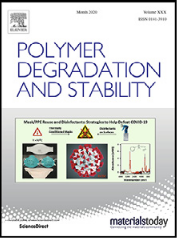 Experimental Analysis and Modeling of Buoyancy-driven Flame Spread on Cast Poly(Methyl Methacrylate) in Corner ConfigurationDushyant M. Chaudhari, Gregory J. Fiola, and Stanislav I. StoliarovPolymer Degradation and Stability, Jan 2021
Experimental Analysis and Modeling of Buoyancy-driven Flame Spread on Cast Poly(Methyl Methacrylate) in Corner ConfigurationDushyant M. Chaudhari, Gregory J. Fiola, and Stanislav I. StoliarovPolymer Degradation and Stability, Jan 2021A new experimental setup was developed to study turbulent, buoyancy-driven flame spread on a corner wall. Two 146 \texttimes 50 \texttimes 0.58 cm panels of cast black poly(methyl methacrylate) (PMMA), whose pyrolysis properties were fully characterized in a separate study, were ignited using a triangular propane burner. The corner wall assembly was placed into a well-ventilated enclosure and heat release rate (HRR) and flame heat flux to the corner wall were measured in 7 repeated experiments. The HRR measurement was designed to achieve a fast response time (13 s) and was correlated with the flame heat flux, which was obtained using water-cooled heat flux gauges positioned in 28 locations distributed over the PMMA surface. Simultaneously, a monochromatic, 900 nm, video of the spreading flame was recorded and analyzed to determine the evolution of soot radiation intensity and flame geometry. Using collected data, an empirical model relating spatially resolved heat feedback from the flame to the solid fuel surface and HRR was developed and integrated with a detailed pyrolysis model. Simulations were conducted in an uncoupled and coupled mode. The uncoupled simulations, where the flame heat feedback was effectively prescribed to match the experimental measurements, revealed the importance of the knowledge of the split between the convective and radiative portions of the flame heat flux. The coupled simulations, where the flame heat feedback was computed from the simulated HRR, revealed that the coupling amplifies even relatively small uncertainties in the model parameters to produce large errors in the HRR predictions.
-
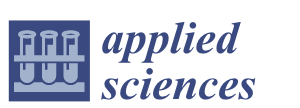 Polyisocyanurate Foam Pyrolysis and Flame Spread ModelingDushyant M. Chaudhari, Stanislav I. Stoliarov, Mark W. Beach , and 1 more authorApplied Sciences (Switzerland), Apr 2021
Polyisocyanurate Foam Pyrolysis and Flame Spread ModelingDushyant M. Chaudhari, Stanislav I. Stoliarov, Mark W. Beach , and 1 more authorApplied Sciences (Switzerland), Apr 2021Polyisocyanurate (PIR) foam is a robust thermal insulation material utilized widely in the modern construction. In this work, the flammability of one representative example of this material was studied systematically using experiments and modeling. The thermal decomposition of this material was analyzed through thermogravimetric analysis, differential scanning calorimetry, and microscale combustion calorimetry. The thermal transport properties of the pyrolyzing foam were evaluated using Controlled Atmosphere Pyrolysis Apparatus II experiments. Cone calorimetry tests were also carried out on the foam samples to quantify the contribution of the blowing agent (contained within the foam) to its flammability, which was found to be significant. A complete pyrolysis property set was developed and was shown to accurately predict the results of all aforementioned measurements. The foam was also subjected to full-scale flame spread tests, similar to the Single Burning Item test. A previously developed modeling approach based on a coupling between detailed pyrolysis simulations and a spatially-resolved relationship between the total heat release rate and heat feedback from the flame, derived from the experiments on a different material in the same experimental setup, was found to successfully predict the evolution of the heat release rate measured in the full-scale tests on the PIR foam.
-
 Experiments and Semi Empirical Modeling of Buoyancy Driven, Turbulent Flame Spread over Combustible Solids in a Corner ConfigurationDushyant M. ChaudhariUniversity of Maryland, College Park , Sep 2021
Experiments and Semi Empirical Modeling of Buoyancy Driven, Turbulent Flame Spread over Combustible Solids in a Corner ConfigurationDushyant M. ChaudhariUniversity of Maryland, College Park , Sep 2021The increased use of engineered complex polymeric materials in the construction industry has highlighted their fire hazard. Screening of these materials, especially during the developmental stage, before safe commercial application requires standardized testing, which can be expensive. This research investigates the possibility of utilization of computational capability to predict fire hazard for facilitating screening of wall-lining materials in an important standardized configuration – a corner geometry without a ceiling. It also aims to fundamentally understand the dynamics of interactions between condensedphase pyrolysis, gas-phase combustion, and flame heat feedback during concurrent, buoyancy-driven flame spread. Consequently, hierarchical experiments and modeling from small-scale to large-scale scenarios were performed using samples having mass in orders of magnitude between a milligram to a kilogram. Small-scale experimental data were inversely analyzed to develop comprehensive pyrolysis models using a hill-climbing optimization technique in a comprehensive pyrolysis solver, ThermaKin. Large-scale experiments performed over a non-charring, non-swelling material with well-characterized condensed-phase pyrolysis – Poly (methyl methacrylate) (PMMA) – provided valuable data for fast-response (13 s response) calorimetry, well-resolved flame heat feedback (maximum \pm 6 kW m-2 error) at 28 locations, and radiation intensities at spectrallyresolved narrowband wavelength (900 \pm 10 nm) corresponding to soot emissions during the flame spread. An empirical flame heat feedback model obtained from large-scale experiments conducted over PMMA was then coupled with the pyrolysis model to develop a low-cost semi-empirical model for simulating fire dynamics during flame spread. The hierarchical experiments and modeling framework was further applied to two important wall-lining materials, Polyisocyanurate foam and Oriented Strand Board, to scrutinize the robustness of the developed modeling framework. The study has presented a systematic methodology that predicted the fire dynamics in the large-scale tests over the three studied materials and can be judiciously extended to other materials. To further improve the largescale modeling predictions, it is necessary a) to reduce the pyrolysis parameter and the flame heat feedback uncertainty below the minimum \pm10% observed uncertainty, b) to quantify the convection-radiation contribution to the flame heat feedback, and c) to investigate the ability to generalize the empirical flame heat feedback model to other materials.
2017
-
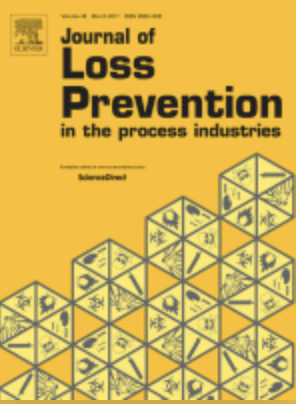 Regulatory Approaches - Safety Case vs US Approach: Is There a Best Solution Today?Prerna Jain, Anne M. Reese, Dushyant M. Chaudhari , and 2 more authorsJournal of Loss Prevention in the Process Industries, Sep 2017
Regulatory Approaches - Safety Case vs US Approach: Is There a Best Solution Today?Prerna Jain, Anne M. Reese, Dushyant M. Chaudhari , and 2 more authorsJournal of Loss Prevention in the Process Industries, Sep 2017In the wake of the August 2012 fire at the Chevron refinery in Richmond, California, the United States (US) Chemical Safety Board proposed the safety case regulatory approach as an alternative to the current approach used in the US today. The current regulations known as the Process Safety Management (PSM) regulations were promulgated in 1992. This followed several highly publicized catastrophic incidents (e.g., Phillips 66 Pasadena, Texas polyethylene plant explosion, 1989; Piper Alpha, North Sea, 1988 and Bhopal, India, 1984). The US approach to regulation is best described as a combination of prescriptive and performance-based regulations that address safety considerations in design and operations. A safety case approach, as used in the United Kingdom (UK), Australia and Norway, requires a detailed analysis of hazards and steps taken to address those hazards, and thus minimize or mitigate the risk. Both the safety case and PSM processes address many of the same aspects such as management of change, identification of hazards and assessment of risks, but the process and format for documentation and regulatory review differs. The question then arises as to the effectiveness of these two regulatory regimes in preventing process safety related incidents. Many reputable organizations and research groups have taken positions regarding whether the US should abandon the existing system of safety regulations. Review of several global incidents has shown that while appropriate hazards and risks were identified, operational shortcomings led to incidents. Uniform and consistent process safety data are in the early stages of being collected and published by such organizations as the American Petroleum Institute (API) and The International Association of Oil & Gas Producers (OGP), using API RP 754 defined metrics. For this paper, data have been collected on oil and gas operations in the US, UK, Norway and Australia to compare the performance of the differing regulatory regimes. While the data are not comprehensive, from existing data on major incidents, spills and fatalities, one cannot conclude that one regulatory regime is superior to the other. Consistent reporting of incidents in a database with appropriate metrics is sorely needed. Furthermore, the authors express the need to move beyond regulatory compliance and suggest research on application of a systems approach to process safety by developing a process resilience analysis framework for process design and operations.




